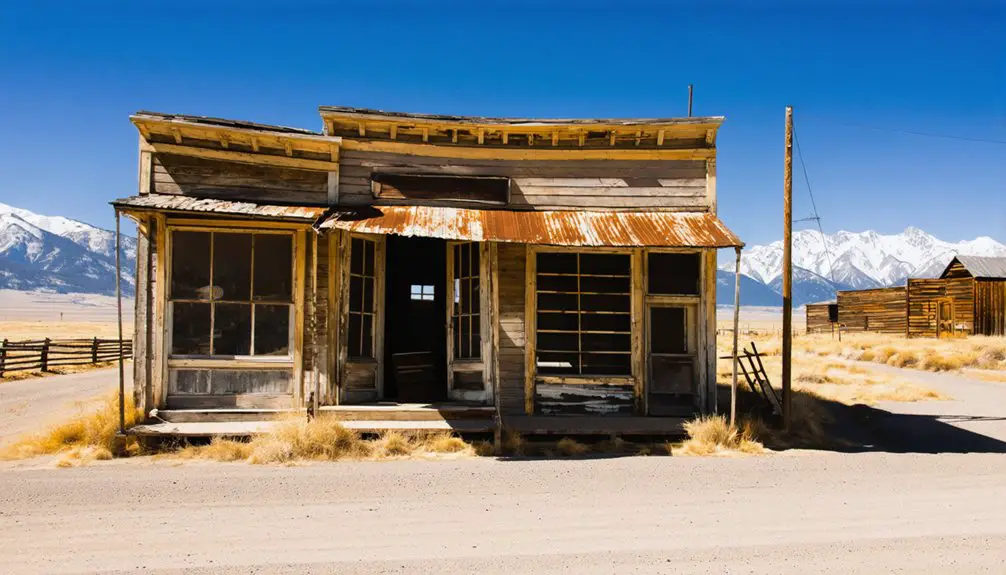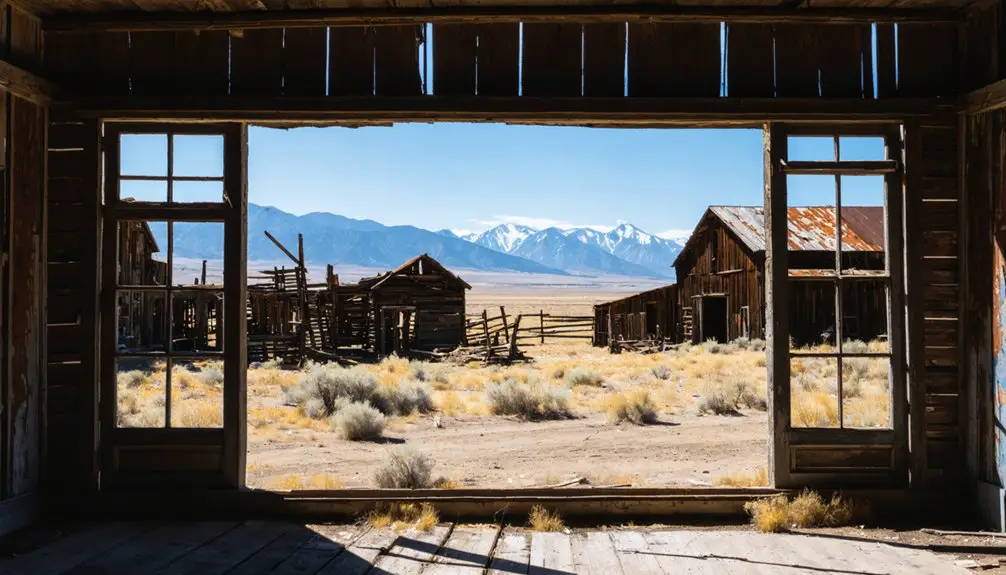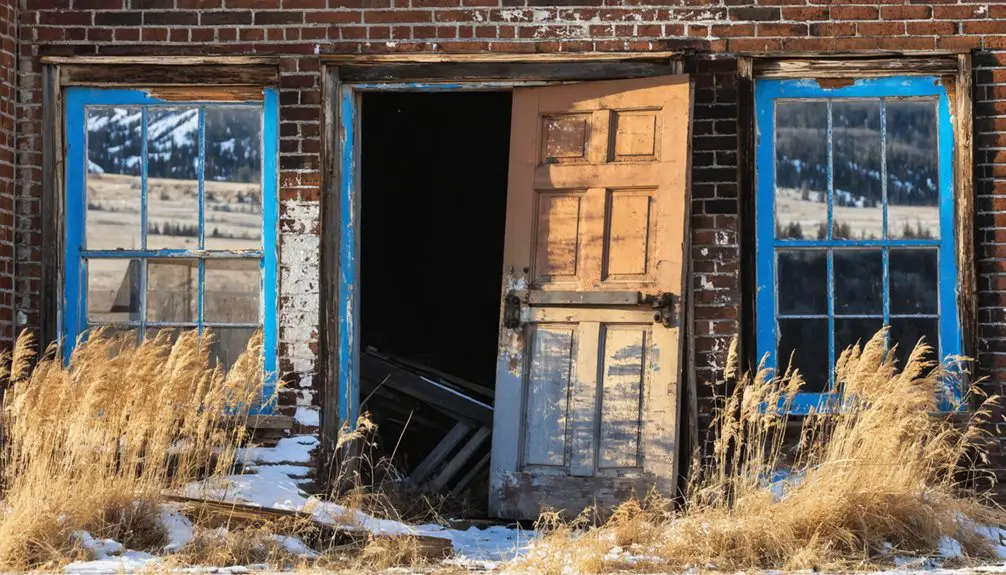You’ll find Stark as a remarkable example of Montana’s mining heritage, emerging in 1862 when prospectors discovered rich deposits of gold, silver, and manganese. The town quickly grew to support 3,000 miners, with eighteen saloons, four hotels, and numerous businesses serving the community. After producing $40 million in silver, operations ceased during the 1893 silver panic. Today, weathered buildings and mining structures tell fascinating tales of frontier life, while local legends speak of supernatural encounters near abandoned shafts.
Key Takeaways
- Stark was a thriving Montana mining settlement that boomed after the 1865 silver discovery and collapsed during the 1893 silver panic.
- The town supported 3,000 miners and produced $40 million in silver before its decline, with monthly production reaching $30,000.
- Community life centered around eighteen saloons, four hotels, and essential businesses that served the mining workforce.
- Remaining structures include log buildings, mining infrastructure, the Miner’s Union Hall, and workshops with corrugated metal linings.
- The ghost town is now preserved through “arrested decay” techniques and offers tourism experiences with self-guided trails.
The Rise of a Mining Settlement
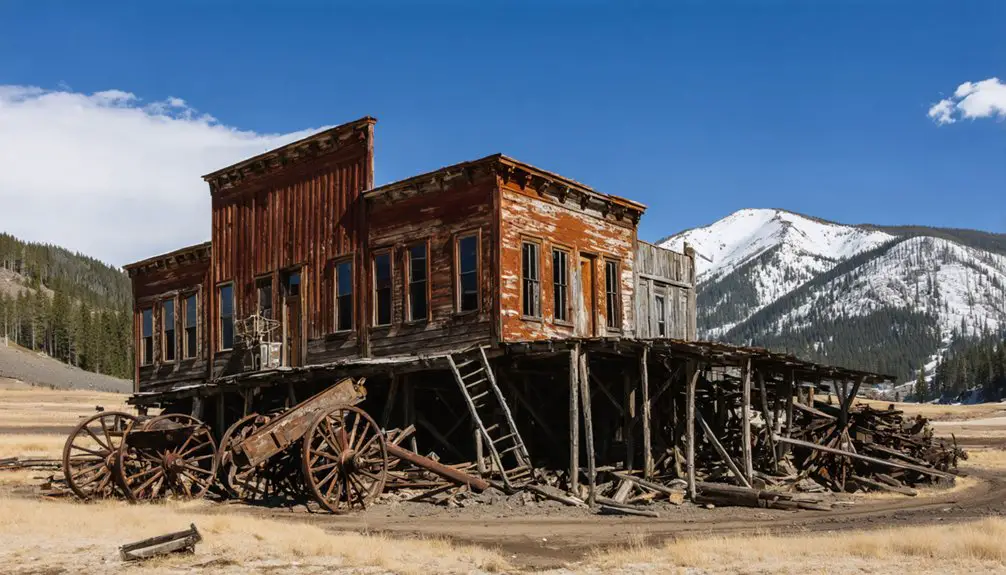
While Montana’s early gold discoveries date back to the 1850s near Deer Lodge, the true mining boom didn’t ignite until 1862 when major strikes at Bannack sparked waves of migration.
You’d have witnessed the birth of Stark during this era of rapid settlement growth, as prospectors flooded the region in search of gold, silver, and manganese.
The settlement’s expansion was remarkable, with mining techniques initially focused on placer mining – a backbreaking process using pans and rockers to separate gold from creek beds.
As word spread of the area’s mineral wealth, you’d have seen the town grow at an astonishing pace of one house per day, eventually attracting 1,500 prospectors.
Infrastructure quickly followed, with cabins and mills sprouting up to support the burgeoning mining operations. Similar to Virginia City’s success, where an estimated $90 million in gold was extracted between 1863 and 1869, Stark’s prosperity seemed promising. The discovery of the Drumlummon Mine in 1876 further solidified Montana’s reputation as a prime mining territory.
Life During the Boom Years
If you’d walked through Stark during its heyday, you would’ve seen miners heading to their daily shifts while merchants kept their stores stocked with essentials and supplies for the growing community.
The town’s commerce revolved around supporting the mining workforce, with general stores, saloons, and boarding houses serving as gathering spots for both temporary and permanent residents. The bustling community was home to eighteen saloons where workers would gather after their shifts.
Community events and social gatherings helped forge bonds among the diverse population, offering relief from the demanding and often dangerous work in the mines.
Daily Work and Commerce
During the boom years of Stark, Montana, mining operations formed the bedrock of daily commerce and work life.
You’d find miners hauling mining equipment to densely packed claims, while stamp mills processed the precious ore that drove the local economy. The silver production of $30,000 flowed through the community each month. The town’s business district buzzed with activity as merchants supplied essential goods and services.
You could trade at multiple stores, barter at the saloons, or conduct business at the assay office to determine your ore’s value. Local entrepreneurs ran hotels, livery stables, and butcher shops to meet your daily needs. Similar to Garnet’s peak, the town supported thirteen saloons where workers gathered after shifts.
Labor unions helped protect your interests, while boarding houses provided shelter after long shifts in the hazardous mines. Despite the lack of formal planning, you’d discover a functional web of commerce where cash and barter transactions kept the community’s economic wheels turning.
Social Gatherings and Entertainment
Anyone seeking entertainment in Stark would find a vibrant social scene centered around the town’s thirteen saloons, which served as the primary gathering spots for miners and residents alike.
You’d discover four bustling hotels hosting social events and dances, while the union hall provided space for community events and miner meetings.
Two barber shops offered places for daily socializing and catching up on local news.
During winter months, you could join others ice skating on the frozen dredge pond, complete with warming houses and skate rentals.
The town’s social venues included butcher shops, candy stores, and drugstores where you’d regularly bump into neighbors.
For outdoor recreation, you’d find picnic areas with fire pits, perfect for family gatherings and community celebrations.
The local family-friendly bowling alley provided year-round entertainment for residents of all ages.
Mining Operations and Economic Impact
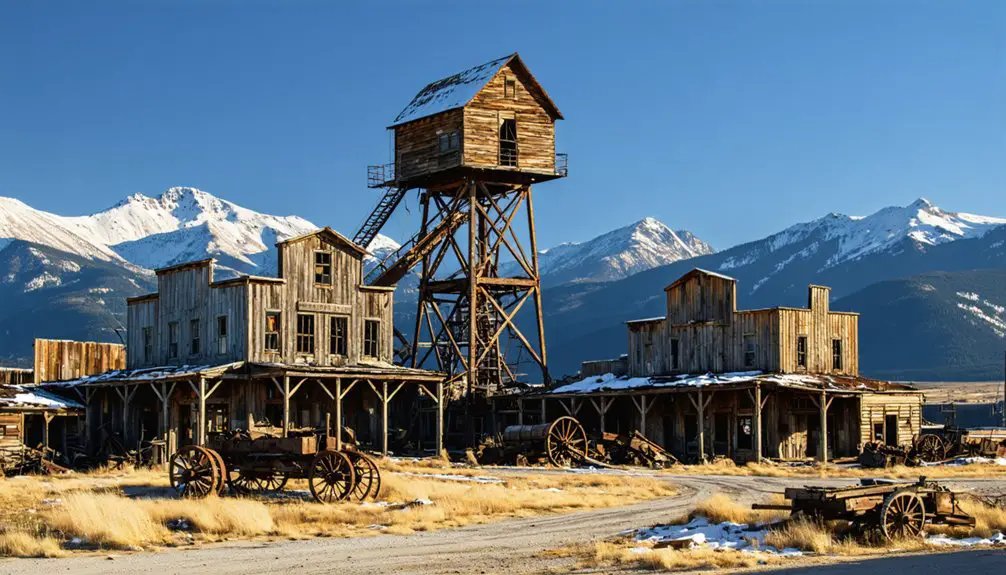
You’ll find the Granite mine’s operations relied on extensive wooden infrastructure, including 1,500-foot-deep vertical shafts and hoist houses that transported silver ore via narrow-gauge rail carts to the processing mill.
The mine’s remarkable $40 million output established Granite as one of the world’s richest silver producers, supporting a thriving population of 3,000 miners and numerous businesses during its peak.
Similar to Garnet which housed four bustling hotels, this boom town exemplified the prosperity of Montana’s mining communities before their eventual decline.
When the silver panic of 1893 struck, operations ceased abruptly, transforming this once-prosperous boomtown into a ghost town that never recovered its former glory. Like other Montana ghost towns, it now provides valuable insights into Old West life, with its abandoned structures telling stories of the mining era.
Mining Equipment and Techniques
The mining operations in Stark relied heavily on advanced equipment and innovative techniques for their time. You’d have found compressed air-powered jackhammers, known as “buzzies,” breaking through rock walls while foot-wide pipes delivered air power throughout the underground network.
Steam-powered donkey engines hauled essential materials, and blacksmith forges maintained the mining tools around the clock.
For ore extraction, miners employed various methods as technology evolved. They started with placer mining using pans and sluices in waterways, then progressed to hydraulic mining with powerful water monitors.
Eventually, hard rock mining became dominant, requiring complex tunnel systems and sophisticated equipment. Stamp mills processed the ore, with facilities like Granite’s 50-stamp mill crushing up to 200 tons daily after its 1891 expansion. The operation was similar to those in Butte, where the Anaconda Copper Mining Company established extensive mining infrastructure.
Economic Rise and Fall
While miners worked with advanced equipment underground, an economic saga unfolded above. You’ll find that Stark’s story mirrors the economic fluctuations common to Montana’s mining towns in the late 1800s.
After silver’s discovery in 1865, the area transformed from wilderness into a bustling hub of 3,000 miners, complete with union halls and superintendent mansions.
The mine’s $40 million silver yield created unprecedented prosperity, spawning hotels, saloons, and schools.
However, mining sustainability proved fragile when the 1893 silver panic struck. Prices plummeted, forcing operations to halt. Within months, miners and their families abandoned their homes, leaving behind empty streets and silent mine shafts.
Today, you can explore these remnants at Granite Ghost Town State Park, where they stand as evidence of Montana’s volatile mining heritage.
Daily Frontier Existence
Living in Stark’s harsh frontier environment demanded remarkable resilience from its 2,000 residents, who endured sparse accommodations and challenging work conditions during the town’s peak.
Your daily routines would’ve revolved around exhausting shifts in the mines, followed by rest in simple bunkhouses or wooden cabins with dirt floors and log-beam ceilings.
Community resilience emerged through three crucial social connections:
Social bonds forged resilience in the community, with three vital gathering places strengthening connections between frontier residents.
- Union and Fraternity Halls hosting gatherings and entertainment
- Saloons serving as hubs for news, commerce, and relaxation
- General stores providing essential supplies and mining equipment
You’d have faced constant hazards, from mining accidents to violent conflicts, while vigilante justice often replaced formal law enforcement.
Despite these challenges, mutual camaraderie flourished as residents banded together, finding strength in their shared frontier experience.
Harsh winters isolated the community for months, testing their spirit and determination to survive in this unforgiving landscape.
Architectural Legacy and Remaining Structures

Today, Stark’s architectural remnants paint a portrait of frontier resourcefulness through its primarily log structures and mining-era infrastructure.
You’ll find the architectural significance of the town revealed in its weathered buildings, from the imposing tramway headhouses to the modest workshops with corrugated metal linings.
A structural analysis shows how miners adapted to the mountainous terrain, using timber retaining walls to support steep slopes and constructing practical buildings focused on function over form.
While over 100 businesses once thrived here, you can still spot traces of community life, including the Miner’s Union Hall and remnants of a print shop.
The town’s utilitarian design reflects its mining heritage, with simple frame construction and log buildings dominating the landscape, though many now lean or have partially collapsed from decades of exposure.
Notable Historical Events
Beyond the architectural remnants, Stark’s historical timeline began with the 1865 discovery of silver in the area, setting off a chain of significant mining developments.
While few records of mining accidents exist, the region’s history was marked by three pivotal events:
- The 1872 discovery of the Granite mine by Holland, which transformed the area into a bustling mining district.
- The establishment of the Comet post office in 1877, signaling the town’s growth and importance as a mining settlement.
- The Nancy Hanks mine’s remarkable gold production of $300,000, proving the region’s mineral wealth.
Historical artifacts found throughout the area tell the story of rapid growth and eventual decline, as the community faced economic hardships and dwindling ore deposits by the early 1900s.
Preservation Status and Tourism Today
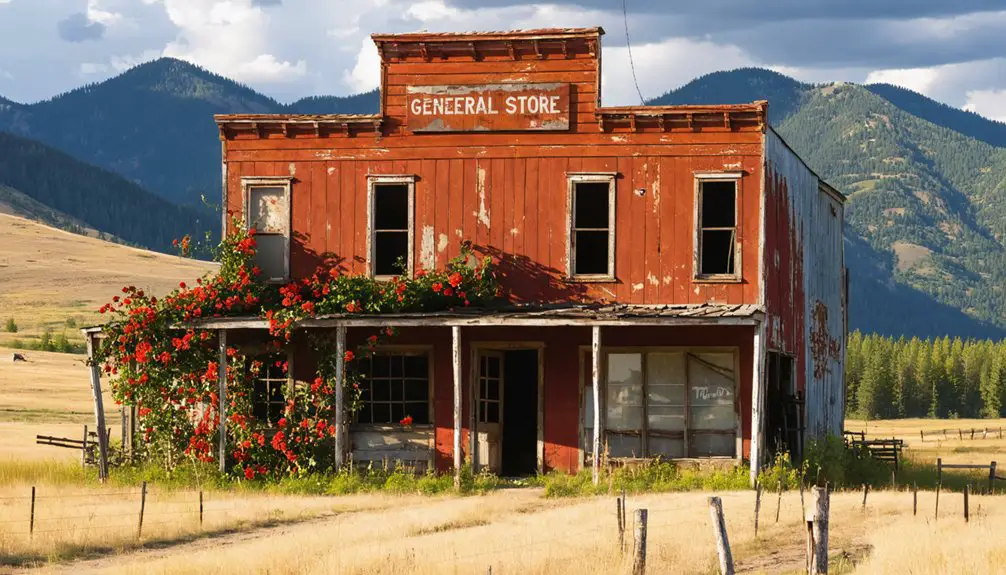
Since its near abandonment in the early 1900s, Stark’s preservation has fallen under the stewardship of multiple organizations working to protect its remaining structures.
You’ll find preservation challenges similar to other Montana ghost towns, with harsh weather and natural decay requiring constant maintenance. Organizations like the Montana Ghost Town Preservation Society have implemented the “arrested decay” technique to stabilize buildings while maintaining their authenticity.
Tourism strategies now focus on providing you with an authentic experience through self-guided trails and interpretive signage.
You can explore the site’s mining heritage through educational exhibits and guided tours when available. While less commercialized than other ghost towns, this approach helps preserve the site’s genuine character while generating necessary revenue for ongoing preservation efforts through visitor fees and donations.
Local Legends and Ghost Stories
Throughout its mining history, Stark’s rugged landscape and dangerous working conditions gave rise to numerous ghost stories that continue to captivate visitors.
You’ll find tales of ghostly encounters near old mine shafts, abandoned buildings, and along the former railroad tracks, where witnesses report spectral sightings of miners and railroad workers in period clothing.
Local legends highlight three prominent hauntings:
- The Ghost Miner who roams near shaft entrances with his pickaxe
- A female spirit, believed to be a miner’s wife, who appears near former residences
- The Spectral Railroad Worker who materializes at twilight by the old railway siding
Many stories trace back to actual historical events, including mining accidents and frontier justice, while traditional wooden grave fences reflect beliefs about containing restless spirits within the cemetery grounds.
Frequently Asked Questions
What Was the Total Amount of Gold Extracted From Stark’s Mines?
You’ll find precise gold production figures from Stark’s mines aren’t documented, but they’re part of Fergus County’s 653,000 ounces, with most coming from lode mining techniques between 1901-1942.
Are There Any Surviving Photographs of Stark During Its Peak Years?
You won’t find any confirmed surviving photographs of Stark’s peak years in historic preservation collections or photographic archives, though similar Montana ghost towns from that era have documented images.
Which Native American Tribes Originally Inhabited the Stark Area?
You’ll find the Crow and Blackfeet tribes primarily claimed this territory, sharing the land’s cultural heritage through hunting grounds and seasonal camps, while Assiniboine and Gros Ventre peoples occasionally traversed the area.
What Happened to the Town’s Last Permanent Resident?
You won’t find specific records naming Stark’s last resident. Like similar ghost towns, they likely departed between the 1930s-1960s when mining declined and basic services became unavailable.
Does Stark Have Any Documented Connections to Famous Wild West Figures?
You won’t find any documented connections between Stark and famous outlaws or legendary lawmen. Unlike Montana’s prominent ghost towns like Bannack or Virginia City, Stark maintained a low profile during the Wild West era.
References
- https://thewave.info/MontanaGhostTownsCode/Map.html
- https://www.youtube.com/watch?v=8DRaKMLZvcs
- https://www.mountain-home.com/blog/vacation-planning/guide-montana’s-ghost-towns
- https://southwestmt.com/blog/ghost-towns/
- https://visitmt.com/things-to-do/ghost-towns
- https://mhs.mt.gov/education/textbook/chapter6/Chapter6.pdf
- https://www.perceptivetravel.com/issues/0620/montana.html
- https://archiveswest.orbiscascade.org/ark:/80444/xv28731
- https://npshistory.com/publications/usfs/region/1/flathead/history/chap3.htm
- https://dp.la/exhibitions/industries-settled-montana/mining
